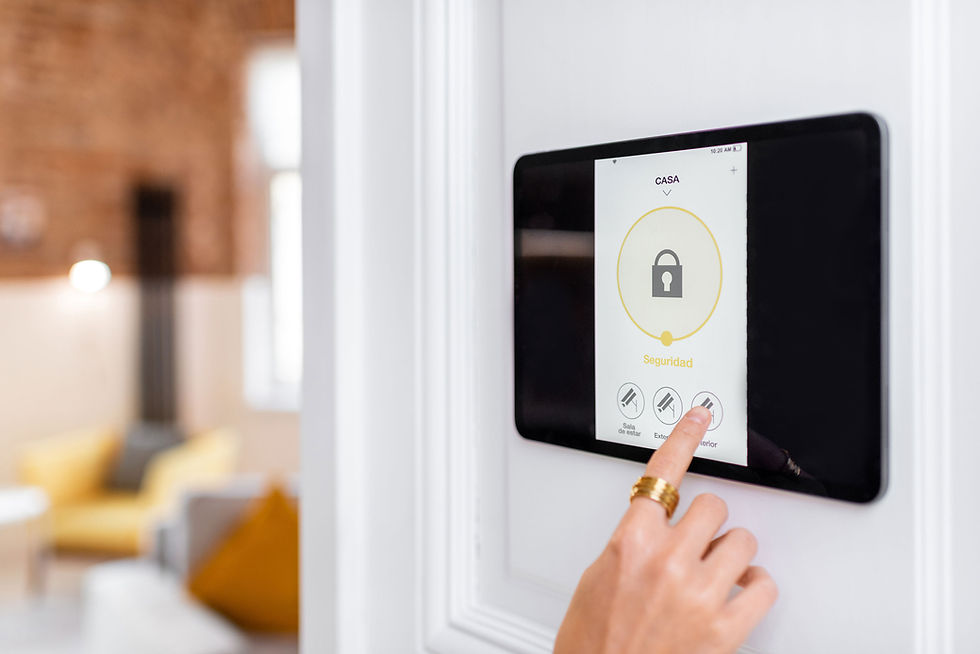Transforming Your Space: A Step-By-Step Guide to Turning Your Home into a Smart Home
- designrequest
- Sep 16, 2023
- 4 min read
The concept of a "smart home" has evolved from science fiction into a reality. With the rapid advancements in technology, it's easier than ever to transform your ordinary house into a smart and connected home. A smart home not only adds convenience but also enhances security, energy efficiency, and overall quality of life. In this blog post, we'll provide a comprehensive step-by-step guide on how to turn your home into a smart home.
Step 1: Define Your Smart Home Goals
Before diving into the world of smart devices, it's essential to identify your goals. What do you want to achieve with a smart home? Consider aspects like convenience, energy efficiency, security, and entertainment. Your goals will help guide your choices and investment in smart technology.

Step 2: Choose Your Ecosystem
One of the key decisions you'll need to make is selecting the smart ecosystem or platform that will serve as the backbone of your smart home. Popular options include Amazon Alexa, Google Assistant, and Apple HomeKit. Each ecosystem has its own set of compatible devices, so choose one that aligns with your existing devices and preferred brand.



Step 3: Start with Smart Assistants
Smart assistants like Amazon Echo, Google Home, or Apple HomePod are a great starting point for your smart home. They serve as a central hub for controlling your smart devices using voice commands. Set up your smart assistant, connect it to your Wi-Fi network, and start using it to control basic tasks and devices.



Step 4: Secure Your Network
The security of your smart home is a top priority. Ensure your Wi-Fi network is secure by using strong passwords and enabling WPA3 encryption. Create a separate network for your smart devices, so they don't compromise your main network's security. Regularly update your router's firmware for added protection.

Step 5: Smart Lighting
Smart lighting is one of the easiest ways to begin your smart home journey. Replace traditional bulbs with smart bulbs from brands like Philips Hue, LIFX, or Wyze. These bulbs can be controlled remotely via your smart assistant or smartphone, allowing you to set schedules, change colors, and even adjust brightness to suit your mood.

Step 6: Smart Thermostats
Upgrade to a smart thermostat like the Nest Learning Thermostat or ecobee. These devices learn your preferences and adjust the temperature accordingly. You can also control them remotely, which helps you save on energy costs by ensuring your home is heated or cooled efficiently.

Step 7: Smart Home Security
Enhance the security of your home with smart cameras and doorbells. Brands like Ring, Arlo, and Nest offer a range of options. These devices provide real-time video monitoring, motion detection, and two-way communication, allowing you to keep an eye on your property even when you're away.

Step 8: Smart Locks
Consider installing a smart lock to increase security and convenience. Brands like August, Schlage, and Yale offer keyless entry and remote control features. You can grant access to guests, service providers, or family members without needing physical keys.

Step 9: Smart Sensors
Smart sensors like motion detectors, contact sensors, and water leak sensors can be placed strategically throughout your home. These sensors can send alerts to your smartphone or trigger specific actions when certain conditions are met, such as turning on lights when motion is detected.

Step 10: Smart Plugs and Outlets
Smart plugs and outlets are affordable options that can turn your existing devices into smart ones. Plug in lamps, appliances, or any device with a plug, and you can control them remotely or set schedules for their operation.

Step 11: Voice Control
Maximize the convenience of your smart home by enabling voice control. Connect your smart assistant to your smart devices and use voice commands to control lighting, temperature, entertainment, and more. It's like having your very own digital butler.

Step 12: Entertainment Center
Upgrade your entertainment center with smart devices like smart TVs, streaming devices (Apple TV, Roku, Chromecast), and smart sound systems. These devices offer voice control, app integration, and compatibility with your smart assistant for a seamless entertainment experience.

Step 13: Automate and Create Scenes
Once you have multiple smart devices, it's time to create automation routines and scenes. Automation allows your devices to work together based on predefined conditions. For example, you can set up a "Good Morning" scene that turns on the lights, adjusts the thermostat, and starts your coffee maker with a single voice command.
Step 14: Monitor and Maintain
Regularly monitor your smart home devices and their performance. Ensure they're updated with the latest firmware and security patches. Over time, new devices may be released, offering better features and compatibility. Consider upgrading or expanding your smart home as technology evolves.

Step 15: Privacy and Security
Be mindful of your privacy and data security. Review the privacy policies of your smart devices and platforms to understand how your data is used. Implement strong passwords, enable two-factor authentication when possible, and use a virtual private network (VPN) for added security.

Transforming your home into a smart home is an exciting journey that offers numerous benefits, from increased convenience and energy efficiency to enhanced security and entertainment. By following this step-by-step guide and carefully considering your goals and device choices, you can create a smart home that suits your lifestyle and makes your daily routines easier and more enjoyable. As technology continues to advance, your smart home will evolve and adapt, offering new possibilities and a more connected way of living.

.png)









































Comments